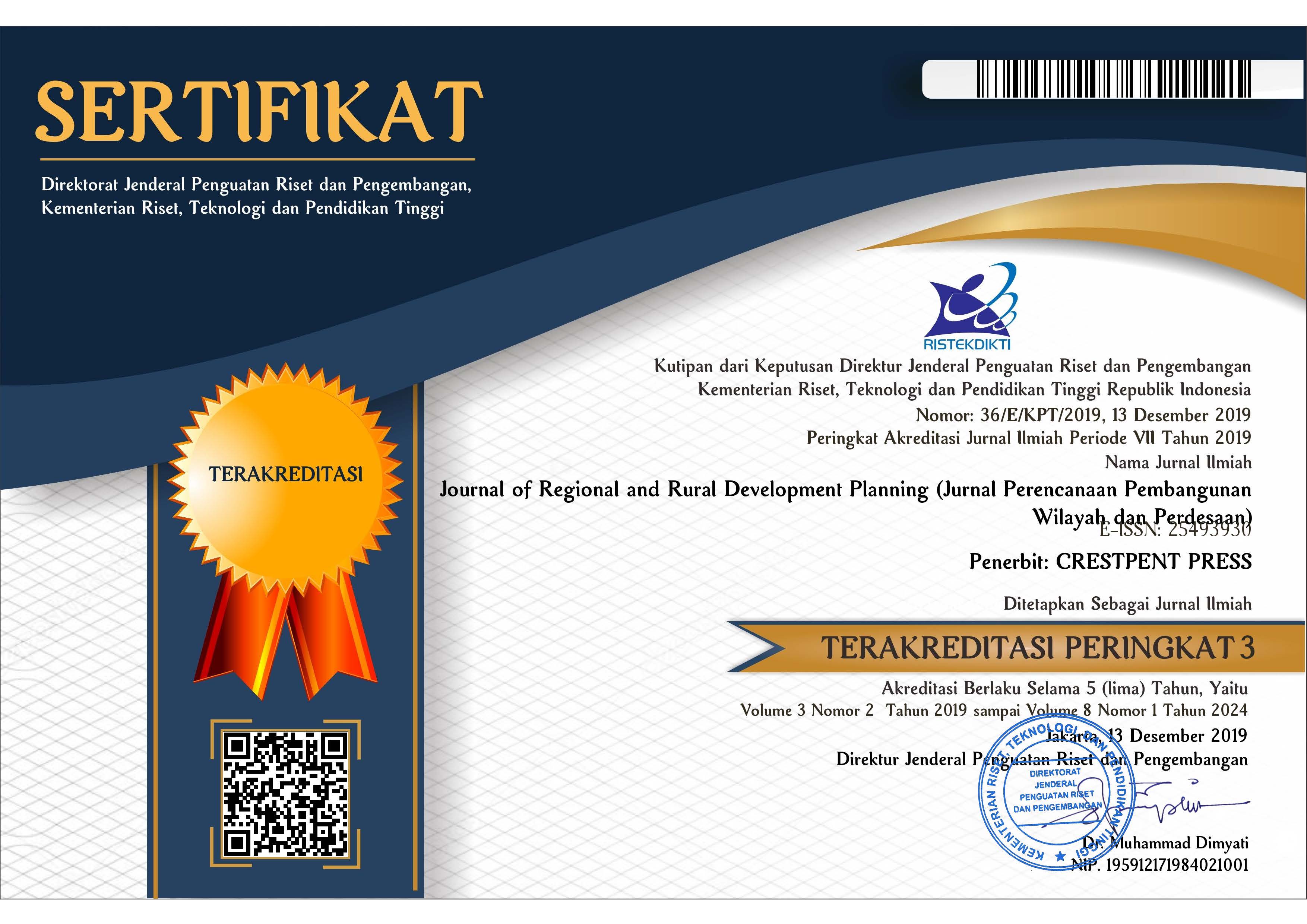Perbedaan Karakteristik Kunjungan ke Ruang Terbuka Hijau di Masa Pandemi Covid-19: Studi Kasus Taman Kota di Kota Bekasi
Differences in the Characteristics of Green Open Space Visits during The Covid-19 Pandemic: A Case Study of City Parks in Bekasi City
Abstract
Green open space is one of the most needed spaces in a city, especially during the Covid-19 pandemic. However, the number of green open spaces in many cities is insufficient. Another problem is the increasing population growth which has an impact on the need for built-up land. The emergence of the Covid-19 pandemic has raised people’s awareness on the need for green open spaces. The presence of green open spaces in the form of city parks is widely used by the community for various activities during the Covid-19 pandemic. Therefore, it is necessary to understand the differences in the use of parks and park visits, both before and during the Covid-19 pandemic. This study aims to analyze the differences between the characteristics of park visits before and during the Covid-19 pandemic and the socioeconomic characteristics of the visitors. Analytical methods used in this study include a cross-tabulation analysis, Chi-square test, and Cramer’s V test to determine whether there are relationships and to identify the strengths of the existing relationship between the characteristics of park visits and visitors before and during the Covid-19 pandemic. Data on the characteristics of park visits and visitors were obtained through an online survey. A number of 141 valid responses were used for further analysis. Results of this study indicated that there are differences in park visits related to the characteristics of visitors before and during the Covid-19 pandemic. The differences in the characteristics of park visits are found in the frequency of visits, duration of visits, and habitual companion.
References
Azagew, S., & Worku, H. (2020). Socio-demographic and physical factors influencing access to urban parks in rapidly urbanizing cities of Ethiopia: The case of Addis Ababa. Journal of Outdoor Recreation and Tourism, 31(June), 100322. https://doi.org/10.1016/j.jort.2020.100322
Burnett, H., Olsen, J. R., Nicholls, N., & Mitchell, R. (2021). Change in time spent visiting and experiences of green space following restrictions on movement during the COVID-19 pandemic: A nationally representative cross-sectional study of UK adults. BMJ Open, 11(3), 1–10. https://doi.org/10.1136/bmjopen-2020-044067
Chiesura, A. (2004). The role of urban parks for the sustainable city. Landscape and Urban Planning, 68(1), 129–138. https://doi.org/10.1016/j.landurbplan.2003.08.003
Geng, D. (Christina), Innes, J., Wu, W., & Wang, G. (2020). Impacts of COVID-19 pandemic on urban park visitation: a global analysis. Journal of Forestry Research, (0123456789). https://doi.org/10.1007/s11676-020-01249-w
Goruntla, N., Bhupalam, P., Jinka, D. R., Thummala, J., Dasari, L. Y., & Bonala, K. K. (2020). Knowledge, Perception, and Practices towards COVID-19 Pandemic among General Public of India: A Cross-sectional online survey. Current Medicine Research and Practice, 10(4), 153–159. https://doi.org/10.1016/j.cmrp.2020.07.013
Kemperman, A. D. A. M., & Timmermans, H. J. P. (2006). Heterogeneity in urban park use of aging visitors: A latent class analysis. Leisure Sciences, 28(1), 57–71. https://doi.org/10.1080/01490400500332710
Lopez, B., Kennedy, C., & Mcphearson, T. (2020). Parks are Critical Urban Infrastructure : Perception and Use of Urban Green Spaces in NYC During COVID-19. Preprints, (August), 1–22. https://doi.org/10.20944/preprints202008.0620.v1
Mahdiar, Z., & Dali, M. (2016). Adolescent use of urban parks and their social environment consequences. Geografia : Malaysian Journal of Society and Space, 12(11), 123–136.
Mak, B. K. L., & Jim, C. Y. (2018). Examining fear-evoking factors in urban parks in Hong Kong. Landscape and Urban Planning, 171(December), 42–56. https://doi.org/10.1016/j.landurbplan.2017.11.012
Mak, B. K. L., & Jim, C. Y. (2019). Linking park users’ socio-demographic characteristics and visit-related preferences to improve urban parks. Cities, 92(July 2017), 97–111. https://doi.org/10.1016/j.cities.2019.03.008
Priess, J., Pinto, L. V., Misiune, I., & Palliwoda, J. (2021). Ecosystem service use and the motivations for use in central parks in three European cities. Land, 10(2), 1–15. https://doi.org/10.3390/land10020154
Public Health England. (2020). Improving access to greenspace. A new review for 2020, 112.
Refshauge, A. D., Stigsdotter, U. K., & Cosco, N. G. (2012). Adults’ motivation for bringing their children to park playgrounds. Urban Forestry and Urban Greening, 11(4), 396–405. https://doi.org/10.1016/j.ufug.2012.06.002
Ries, A. V., Voorhees, C. C., Roche, K. M., Gittelsohn, J., Yan, A. F., & Astone, N. M. (2009). A Quantitative Examination of Park Characteristics Related to Park Use and Physical Activity Among Urban Youth. Journal of Adolescent Health, 45(3 SUPPL.), S64–S70. https://doi.org/10.1016/j.jadohealth.2009.04.020
Shan, X. Z. (2014a). Socio-demographic variation in motives for visiting urban green spaces in a large Chinese city. Habitat International, 41, 114–120. https://doi.org/10.1016/j.habitatint.2013.07.012
Shan, X. Z. (2014b). The socio-demographic and spatial dynamics of green space use in Guangzhou, China. Applied Geography, 51, 26–34. https://doi.org/10.1016/j.apgeog.2014.03.006
Shi, L., Halik, Ü., Abliz, A., Mamat, Z., & Welp, M. (2020). Urban green space accessibility and distribution equity in an arid oasis city: Urumqi, China. Forests, 11(6). https://doi.org/10.3390/F11060690
Tim BPS Covid-19 Statistical Task Force. (2020). Hasil Survei Perilaku Masyarakat Di Masa Pandemi Covid-19 (7-14 September 2020). Perilaku Masyarakat di Masa Pandemi Covid-19 BPS RI (Vol. 19).
Ugolini, F., Massetti, L., Calaza-Martínez, P., Cariñanos, P., Dobbs, C., Ostoic, S. K., … Sanesi, G. (2020). Effects of the COVID-19 pandemic on the use and perceptions of urban green space: An international exploratory study. Urban Forestry and Urban Greening, 56(20). https://doi.org/10.1016/j.ufug.2020.126888
Wilkerson, M. L., Mitchell, M. G. E., Shanahan, D., Wilson, K. A., Ives, C. D., Lovelock, C. E., & Rhodes, J. R. (2018). The role of socio-economic factors in planning and managing urban ecosystem services. Ecosystem Services, 31, 102–110. https://doi.org/10.1016/j.ecoser.2018.02.017
Copyright (c) 2022 Journal of Regional and Rural Development Planning (Jurnal Perencanaan Pembangunan Wilayah dan Perdesaan)

This work is licensed under a Creative Commons Attribution-ShareAlike 4.0 International License.




.png)














